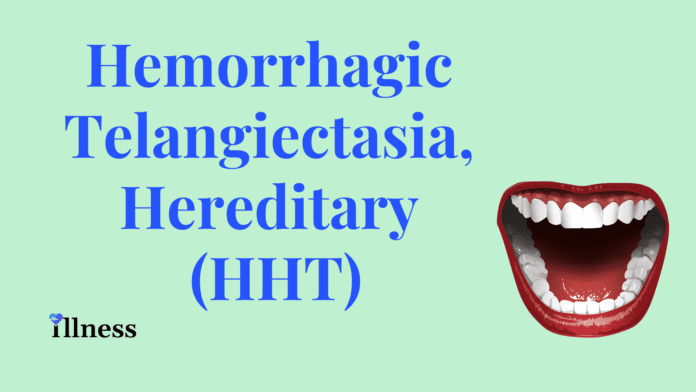Overview Of Hereditary Hemorrhagic Telangiectasia (HHT)
Hereditary Hemorrhagic Telangiectasia (HHT) is an inherited disorder of the blood vessels that can cause excessive bleeding.
Commonly Associated With
Osler-Weber-Rendu syndrome; Osler-Weber-Rendu disease; Rendu-Osler-Weber syndrome
Causes Of Hereditary Hemorrhagic Telangiectasia (HHT)
HHT is passed down through families in an autosomal dominant pattern. This means the abnormal gene is needed from only one parent in order to inherit the disease.
Scientists have identified four genes involved in this condition. All of these genes appear to be important for blood vessels to develop properly. A mutation in any one of these genes is responsible for HHT.
Symptoms Of Hereditary Hemorrhagic Telangiectasia (HHT)
People with HHT can develop abnormal blood vessels in several areas of the body. These vessels are called arteriovenous malformations (AVMs).
If they are on the skin, they are called telangiectasias. The most common sites include the lips, tongue, ears, and fingers. The abnormal blood vessels can also develop in the brain, lungs, liver, intestines, or other areas.
Symptoms of this syndrome include:
- Frequent nosebleeds in children
- Bleeding in the gastrointestinal tract (GI), including loss of blood in the stool, or dark or black stools
- Seizures or unexplained, small strokes (from bleeding into the brain)
- Shortness of breath
- Enlarged liver
- Heart failure
- Anemia caused by low iron
Exams & Tests
The health care provider will perform a physical examination and ask about your symptoms. An experienced provider can detect hereditary hemorrhagic telangiectasia during a physical examination. There is often a family history of this condition.
Tests include:
- Blood gas tests
- Blood tests
- An imaging test of the heart called an echocardiogram
- Endoscopy, which uses a tiny camera attached to a thin tube to look inside your body
- MRI to detect AVMs in the brain
- CT or ultrasound scans to detect AVMs in the liver
- Genetic testing is available to look for changes in genes associated with this syndrome.
Treatment Of Hereditary Hemorrhagic Telangiectasia (HHT)
Treatments may include:
- Surgery to treat bleeding in some areas
- Electrocautery (heating tissue with electricity) or laser surgery to treat frequent or heavy nosebleeds
- Endovascular embolization (injecting a substance through a thin tube) to treat abnormal blood vessels in the brain and other parts of the body
- Some people respond to estrogen therapy, which can reduce bleeding episodes. Iron may also be given if there is a lot of blood loss, leading to anemia. Avoid taking blood-thinning medicines. Some drugs that affect blood vessel development are being studied as possible future treatments.
- Some people may need to take antibiotics before having dental work or surgery. People with lung AVMs should avoid scuba diving to prevent decompression sickness (the bends). Ask your provider what other precautions you should take.



